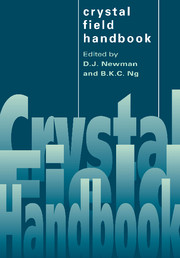Book contents
- Frontmatter
- Contents
- List of contributors
- Preface
- Introduction
- 1 Crystal field splitting mechanisms
- 2 Empirical crystal fields
- 3 Fitting crystal field parameters
- 4 Lanthanide and actinide optical spectra
- 5 Superposition model
- 6 Effects of electron correlation on crystal field splittings
- 7 Ground state splittings in S-state ions
- 8 Invariants and moments
- 9 Semiclassical model
- 10 Transition intensities
- Appendix 1 Point symmetry
- Appendix 2 QBASIC programs
- Appendix 3 Accessible program packages
- Appendix 4 Computer package CST
- Bibliography
- Index
4 - Lanthanide and actinide optical spectra
Published online by Cambridge University Press: 10 December 2009
- Frontmatter
- Contents
- List of contributors
- Preface
- Introduction
- 1 Crystal field splitting mechanisms
- 2 Empirical crystal fields
- 3 Fitting crystal field parameters
- 4 Lanthanide and actinide optical spectra
- 5 Superposition model
- 6 Effects of electron correlation on crystal field splittings
- 7 Ground state splittings in S-state ions
- 8 Invariants and moments
- 9 Semiclassical model
- 10 Transition intensities
- Appendix 1 Point symmetry
- Appendix 2 QBASIC programs
- Appendix 3 Accessible program packages
- Appendix 4 Computer package CST
- Bibliography
- Index
Summary
The basic theory used to interpret the electronic energy level structure observed experimentally in lanthanide (4fn) and actinide (5fn) ions in crystals has been considerably refined since the fundamental work of the 1950s [Jud63, Jud88, Wyb65a, Die68, Hüf78]. In addition to formal developments that fully explore the symmetry properties of the electronic structure of an f element ion, theoretical modelling of the electronic structure utilizes Hartree–Fock methods to estimate the primary interactions within a free magnetic ion. For dealing with ion–ligand interactions, a ‘crystal field’ theory has been developed based on the one-electron approximation (see Chapter 1) together with the assumption that the crystal field interaction is weak in comparison with electronic interactions within the f element ion. While the aspects of energy level splitting that are symmetry related are well understood, this is not true of the mechanisms that determine the magnitude of the splitting. Therefore, a semi-empirical approach has been employed which attempts to identify those effective interactions operating within the f configurations that reproduce the observed energy level structure [Jud63, Die68] (see Chapter 2). Due to the systematic work of Carnall and coworkers since the 1970s [CBC+83, CGRR89, CLWR91, Car92, CC84, JC84] this phenomenological, or parametric modelling, approach has proven very powerful for analysing experimental spectra of both lanthanide and actinide ions.
- Type
- Chapter
- Information
- Crystal Field Handbook , pp. 65 - 82Publisher: Cambridge University PressPrint publication year: 2000
- 2
- Cited by

